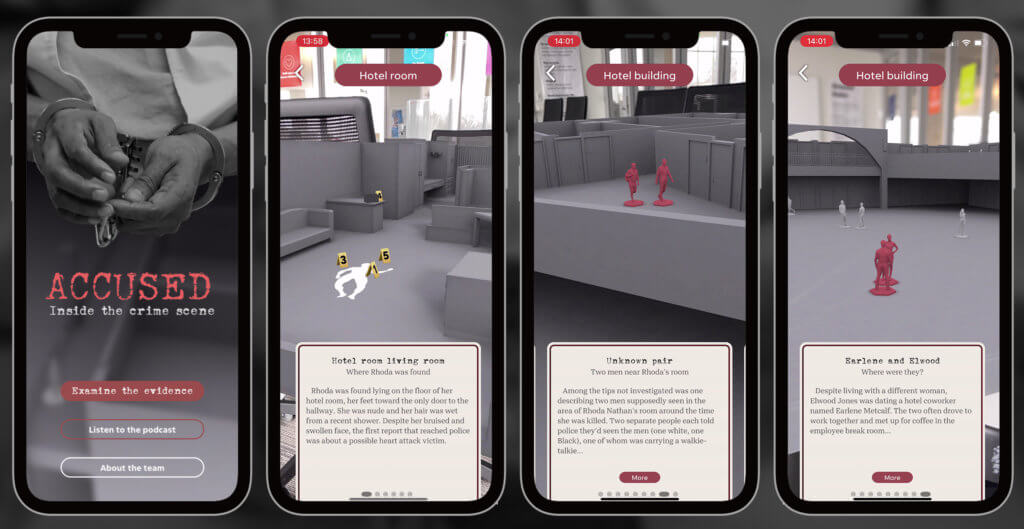One of America’s great pastimes is going down the rabbit hole on an in-depth true-crime podcast. But, as a story becomes more complex, it becomes harder to follow along without visual aid. To tackle a particularly sticky story, USA TODAY created an AR experience to help listeners of their Accused podcast to follow even more clues.
We talked with Gannett senior director of emerging tech Ray Soto and senior designer of emerging tech Will Austin about how they made the AR tool in line with the podcast’s ethos as well as how they handled respect for the deceased and sensitivity toward viewers.
A Crime Scene That Has to Be Seen
Accused is a special project of Gannett’s Cincinnati Enquirer (part of the USA TODAY Network). Each season of the podcast, currently in its fourth season, is a deep dive into a true crime case with host Amber Hunt and her team.

The most recent season, “The Impending Execution of Elwood Jones”, is already available to USA TODAY, the Cincinnati Enquirer, and Wondery+ subscribers, while non-subscribers will be able to watch it weekly, starting February 8, on Wondery, Apple Podcasts, Stitcher, and Spotify. Jones was convicted for “the mysterious murder of Rhoda Nathan” but, as any true crime fan will tell you, convictions aren’t always the same as guilt.
The case is so complicated that some listeners of the true-crime podcast might want to feel a little closer to it than they can get with just audio. So, last summer while the season was still in production, the podcast team reached out to Gannett’s Emerging Tech team to see how augmented reality could help unveil the truth.
USA TODAY Augmenting a Real Crime Scene
“The Emerging Tech team was developed seven years ago and our plan was to innovate,” Soto told ARPost. “We see this opportunity to start thinking about how USA TODAY appears as a product on devices going forward… Not just to treat the technology as one-off stories but to ask how is it a part of the ecosystem going forward.”
Press materials shared with ARPost call the resulting experience USA TODAY’s “largest AR launch to date,” but it certainly isn’t their first. That didn’t make this an easy project. The team had to balance the technical challenges of an AR experience with the journalistic challenges of the true-crime subject matter.
“Our team has been really fortunate to have experience with this kind of thing,” said Austin. “We’ve worked with a lot of teams to make sure that we’re handling things in a respectful way.”
The team also had the marketing and artistic challenges of creating an augmented reality experience for an inherently audio audience.
“When (listeners) see ‘AR’ there is a segment of them that knows what it is and are excited about it but the challenge is getting a wider segment interested,” said Soto. On the other hand, “It was an opportunity to reach an audience that might not be aware of the podcast.”
So, what does the AR experience bring to the table?
Experiencing True Crime
When users access the experience through the USA TODAY app, they place an AR model of the crime scene on a flat surface in their physical environment. From there, users can select elements in the scene to explore images, audio, and text annotations. They can also choose to skip audio or go to the full podcast.

“There were several steps that we had to go through in order to make sure that everything was accurate and everything was to scale,” said Austin, “Things you can hear we left to the podcast and things you need to see we brought into AR.”
The result is an experience that is both user-friendly and stylistically familiar to fans of true crime. The elements to select include a body outline, evidence tags, and items in the virtual environment. In addition to being user-friendly and stylized, the team wanted to treat the delicate subject matter with respect.
“We’re dealing with true crime, so with reference to those involved we wanted to be respectful and we didn’t want to traumatize people or sensationalize,” said Austin. “We didn’t want to show all of the evidence as visceral as it was, we just wanted to contextualize the information.”
Because the main goal of the experience was to drive dialogue, it was also important to Austin that the experience be accessible to people with different usability needs and accommodations.
The AR experience is now live, but that doesn’t mean that the Emerging Tech team is done. With each AR activation that the team creates, they poll users and monitor responses and interactions so that they can optimize their software as well as the next experience.

This experience was launched on a recently updated framework that incorporated lessons learned from previous experiences followed by user engagement studies. The goal is to continually make more useful tools for getting users the information that they need in the way that works best for them.
“We’ve consistently learned more and more. Interactive mediums will always be there and we see it getting more and more involved,” said Austin. “We’re going to have a lot of different tools to paint the world in different ways.”
Understanding Evidence in AR
Augmented reality is a fun tool, but this true crime use case helps to show how practical it can be. This experience gave podcast listeners a birds-eye view of a real crime scene, and it’s easy to think of how this kind of technology could be used to give law enforcement, justices, and jurors the same information. We might have fewer podcasts about potential wrongful convictions.




